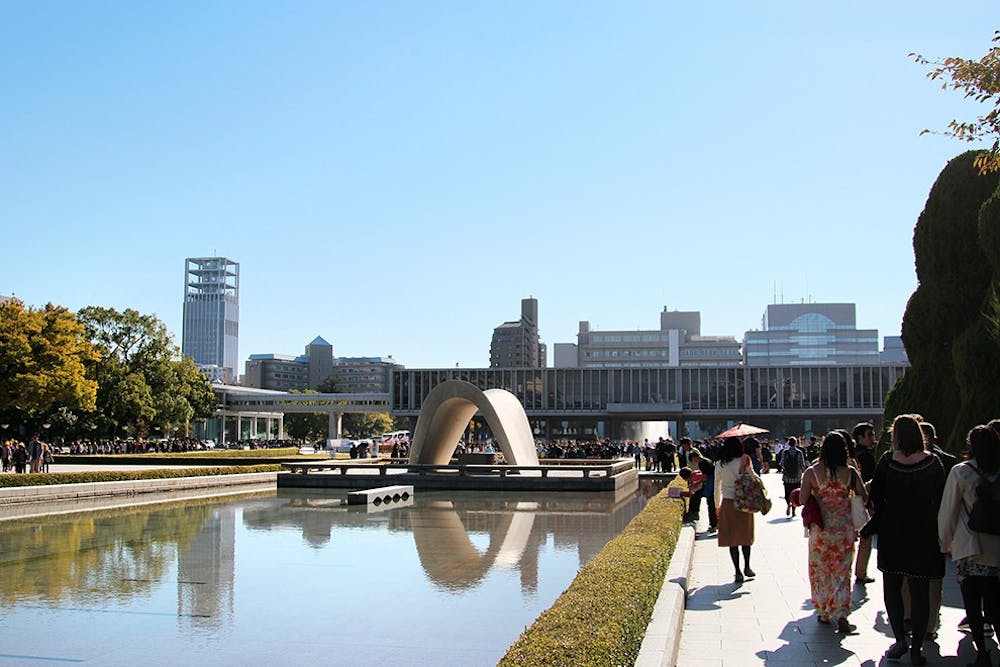I first learned about the bombing of Hiroshima in the ninth grade. We were assigned John Hersey’s “Hiroshima,” a long-form article that follows six survivors as they navigate the horrific aftermath of the atomic bomb. The article told of a city completely leveled, of all-engulfing fires, of dying infants, of severed breasts, of burnt skin melting off of faces and limbs. The images made a deeper impression on me than did most things from my high school education. I thought I knew about Hiroshima — what had happened, what had followed.
This fall break, I had the opportunity to visit Hiroshima for the first time with ART 429: Visual Japan, Past and Present. Prior to our trip, my professor had assigned Hersey’s book as well as the first volume of “Barefoot Gen,” a renowned autobiographical manga of one survivor’s childhood after the bomb. I had thought myself prepared for the descriptions of suffering and of gore — prepared, albeit in a cursory sense, for the “facts.” Nevertheless, the Hiroshima Peace Memorial Park took me by utter surprise.

The “street” I am writing about today has no name. It is a straight path, wide enough to be a boulevard in any large city, that leads from the northeast entrance of the over 1,300,000-square foot park to the Hiroshima Peace Memorial Museum. The long series of monuments begin at the northern end with what is known in English as the Children’s Peace Monument (the Japanese literally translates to “Statue of the Children of the Atomic Bomb”). The statue, which depicts a girl with a large origami crane above her, is based on the true story of Sadako Sasaki, a bombing victim who was only two years old in 1945 and suffered from no long-term symptoms until 1954, when she developed leukemia and died just one year later. Sadako’s belief that she would be cured if she folded 1,000 paper cranes became the origin for the now-universal connotation of peace found in paper cranes.
Nowadays, Sadako’s statue is surrounded by thousands of paper cranes sent from all around the world, enclosed in an enclave of glass cases. (Some of the recycled cranes have been made into postcards that act as entrance tickets to the museum.) As we examined the rainbows of cranes, we found ourselves surrounded by a group of Japanese elementary schoolchildren. At their teacher’s cue, the children began to recite pledges: pledges to be good to their parents, to value their friends, to recognize the importance of the people in their lives. This was followed by a song, one of the lines being, “The lives of my country’s peoples and other countries’ peoples are worth the same.” Behind them, older children salute the statue and hold moments of silence.
The remaining road to the museum is no less saturated with such explicit salutations to peace — from the Peace Flame, lit in 1964 and which will continue to burn until every nuclear weapon in the world is destroyed, to the Peace Fountain, erected in honor of the burn victims’ requests for water, and finally to the Memorial Cenotaph near the center of the park. The Cenotaph, which holds the names of all those killed by the bomb, is covered by a saddle-shaped, concrete arch that, when looked through its center, aligns the Flame, the Children’s Peace Monument and, all the way across the river, the A-Bomb Dome — the building closest to the hypocenter of the explosion that remained partially standing. The Dome has been kept in its half-ruined state for 70 years now, and stands as a symbol for reflection on the nation’s catastrophic memories.
In hindsight, when approaching a straight-edged boulevard with an arch in its center, the design’s intention for visitors to look back on all these monuments seems intuitive. Yet the distractions were endless: the sprawling crowds of visitors (despite it being a regular weekday), the songs, the potent symbolism of each monument and the schoolchildren approaching foreigners with their field trip assignment, nervously asking in English for people’s hometowns and “peace messages” in exchange for paper cranes.
Whatever the reason, the image through the arch came as a shock. It is a shock that, even after writing all this, I have yet to fully digest. What does it mean to maintain a ruin as a ruin, a gaping wound in a healing city? What does it mean to condemn violence with images of the most extreme violence? How does one teach children to categorically promote “peace,” almost as a motto, and why don’t we see this more often?
I have long been told that Hiroshima is a place that every person in the world should visit. In this sense, seeing it in person was somehow both underwhelming and overwhelming; I was not shaken to tears, like many have reported, but I was certainly shaken, and thoughtful, and will continue to be for — the cliché is not used lightly here — the rest of my life.










